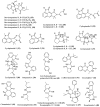Deep-Sea Fungi Could Be the New Arsenal for Bioactive Molecules
- PMID: 31861953
- PMCID: PMC7024341
- DOI: 10.3390/md18010009
Deep-Sea Fungi Could Be the New Arsenal for Bioactive Molecules
Abstract
Growing microbial resistance to existing drugs and the search for new natural products of pharmaceutical importance have forced researchers to investigate unexplored environments, such as extreme ecosystems. The deep-sea (>1000 m below water surface) has a variety of extreme environments, such as deep-sea sediments, hydrothermal vents, and deep-sea cold region, which are considered to be new arsenals of natural products. Organisms living in the extreme environments of the deep-sea encounter harsh conditions, such as high salinity, extreme pH, absence of sun light, low temperature and oxygen, high hydrostatic pressure, and low availability of growth nutrients. The production of secondary metabolites is one of the strategies these organisms use to survive in such harsh conditions. Fungi growing in such extreme environments produce unique secondary metabolites for defense and communication, some of which also have clinical significance. Despite being the producer of many important bioactive molecules, deep-sea fungi have not been explored thoroughly. Here, we made a brief review of the structure, biological activity, and distribution of secondary metabolites produced by deep-sea fungi in the last five years.
Keywords: bioactive compounds; deep-sea; ecosystem; extreme; fungi; secondary metabolites.
Conflict of interest statement
The authors declare that they have no competing interests.
Figures








References
-
- Deshmukh S.K., Prakash V., Ranjan N. Recent advances in the discovery of bioactive metabolites from Pestalotiopsis. Phytochem. Rev. 2017;16:883–920. doi: 10.1007/s11101-017-9495-3. - DOI
Publication types
MeSH terms
Substances
LinkOut - more resources
Full Text Sources
Medical

